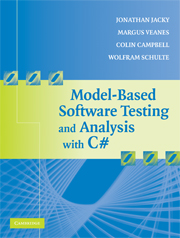3 - Why We Need Model-Based Analysis
Published online by Cambridge University Press: 02 March 2010
Summary
This chapter demonstrates why we need model-based analysis. We exhibit a program with design errors that cause safety violations (where the program reaches forbidden states), deadlocks (where the program seems to stop running and stops responding to events), and livelocks (where the program cycles endlessly but can't make progress). We preview our analysis and visualization techniques and show how they can reveal the design errors, even before beginning any testing.
Reactive system
Suppose we are developing a process control program that runs on an embedded computer connected to sensors, timers, and a supervisor program (Figure 3.1). The temperature monitor discussed in Chapter 2 could be a component of this system; here we consider a higher level of integration. This is a reactive system that responds to events in its environment. In this chapter we consider just one of its features: the temperature-calibration factor. The controlled process depends on the temperature. In order to control the process accurately, the control program must obtain a temperature reading from a sensor and use it to compute the calibration factor. The calibration factor is then used in subsequent process control computations (which we do not discuss here).
The temperature in the process can change continuously, so the control program must sample the temperature often. The control program frequently polls the sensor (requests a sample). The sensor usually responds with a message that contains the most recently measured temperature. We distinguish controllable actions that the program commands from observable actions that originate in the attached equipment. All that the program can do in regard to observable actions is to wait for them (and observe them).
- Type
- Chapter
- Information
- Model-Based Software Testing and Analysis with C# , pp. 32 - 52Publisher: Cambridge University PressPrint publication year: 2007

